Investigation of Induced Charge Mechanism on a Rod Electrode
Abstract
:1. Introduction
2. Induced Charge Model on Rod Electrode by Point Charge
2.1. Step 1 Select A Random Point On the Electrode Surface
2.2. Step 2 Apply the Method of Images
2.3. Step 3 Verify the Suppose Satisfies the Uniqueness Theorem
- (1)
- In addition to the position where the point charge is located, is satisfied everywhere, and is the potential.
- (2)
- Taking infinity as the reference point, the potential at the interface between the medium and conductor L is zero.
- (3)
- The direction of the electric field line is unchanged, which is the direction of the vertical electrode surface pointing to the axis.
2.4. Step 4 Calculate the Combined Field Strength
2.5. Step 5 Calculate the Total Amount of Charge
3. Characteristics of Induced Charge on a Rod Electrode
3.1. Induced Charge Distribution under the Effect of Point Charge
3.2. Quantity of Charge Induced by Moving Point Charge
3.2.1. Effect of Distance between Electrode and Point Charge
3.2.2. Effect of Electrode Length
3.2.3. Effect of Electrode Radius
4. Induced Current on a Rod Electrode by Moving Point Charge
4.1. Simulation for Induced Current
4.2. Spectrum of Induced Current
4.3. Analysis of the Variation of the Induced Current Spectrum over the Effective Range
4.4. Measurement Circuit Analysis
5. Experimental Study and Discussion
5.1. Experimental Setup
5.2. Results and Discussion
- (1)
- (2)
- (3)
- (4)
- When the velocity and the value are fixed, the change in the amount of the charge on the ball does not influence the spectral characteristics of the induced current signal, which can be observed in Figure 23b,d.
6. Conclusions
- The amount of the induced charge on the rod electrode are mainly determined by the following factors: The distance between the point charge and the electrode, the radius and the length of the electrode.
- The general model of the relationship between the induced current and velocity is established and the spectrum of the induced current is studied. The induced current increases with the increase of the point charge’s velocity and the maximum value of the induced current is linearly proportional to the point charge’s velocity. The faster the velocity of the point charge, the wider the spectrum of the induced current. The further the point charge from the rod electrode, the narrower the spectrum of the induced current on the rod electrode.
- For the measurement circuit, its amplification ratio and pass-band width are determined by the feedback resistance and feedback capacitance, respectively. With the increase of the feedback resistance, the amplification factor of the circuit increases. With the increase of the feedback capacitance, the pass-band width of the measurement circuit becomes narrower.
Author Contributions
Funding
Acknowledgments
Conflicts of Interest
References
- Lebecki, K.; Małachowski, M.; Sołtysiak, T. Continuous dust monitoring in headings in underground coal mines. J. Sustain. Min. 2016, 15, 125–132. [Google Scholar] [CrossRef]
- Brodny, J.; Tutak, M. Exposure to Harmful Dusts on Fully Powered Longwall Coal Mines in Poland. Int. J. Environ. Res. Public Health 2018, 15, 1846. [Google Scholar] [CrossRef] [PubMed]
- Jeong, W.; Jeon, S.; Jeong, D. Advanced Backstepping Trajectory Control for Skid-Steered Duct-Cleaning Mobile Platforms. Electronics 2019, 8, 401. [Google Scholar] [CrossRef]
- Mataloto, B.; Ferreira, J.C.; Cruz, N. LoBEMS—IoT for Building and Energy Management Systems. Electronics 2019, 8, 763. [Google Scholar] [CrossRef]
- Marques, G.; Pitarma, R. A Cost-Effective Air Quality Supervision Solution for Enhanced Living Environments through the Internet of Things. Electronics 2019, 8, 170. [Google Scholar] [CrossRef]
- Arroyo, P.; Lozano, J.; Suárez, J.I. Evolution of Wireless Sensor Network for Air Quality Measurements. Electronics 2018, 7, 342. [Google Scholar] [CrossRef]
- Gajewski, J. Electrostatic Nonintrusive Method for Measuring the Electric Charge, Mass Flow Rate, and Velocity of Particulates in the Two-Phase Gas–Solid Pipe Flows—Its Only or as Many as 50 Years of Historical Evolution. IEEE Trans. Ind. Appl. 2008, 44, 1418–1430. [Google Scholar] [CrossRef]
- Weinheimer, A.J. The charge induced on a conducting cylinder by a point charge and its application to the measurement of charge on precipitation. J. Atmos. Ocean. Technol. 1988, 5, 298–304. [Google Scholar] [CrossRef]
- Woodhead, S.R.; Amadi-Echendu, J.E. Solid phase velocity measurement utilizing electrostatic sensors and cross correlation signal processing. In Proceedings of the 1995 IEEE Instrumentation and Measurement Technology Conference, Waltham, MA, USA, 23–26 April 1995; pp. 774–777. [Google Scholar]
- Gajewski, J.B. Non-contact electrostatic flow probes for measuring the flow rate and charge in the two-phase gas–solids flows. Chem. Eng. Sci. 2006, 61, 2262–2270. [Google Scholar] [CrossRef]
- Yan, Y.; Byrne, B.; Woodhead, S.; Coulthard, J. Velocity measurement of pneumatically conveyed solids using electrodynamic sensors. Meas. Sci. Technol. 1995, 6, 515–537. [Google Scholar] [CrossRef]
- Qian, X.; Yan, Y.; Huang, X.; Hu, Y. Measurement of the Mass Flow and Velocity Distributions of Pulverized Fuel in Primary Air Pipes Using Electrostatic Sensing Techniques. IEEE Trans. Instrum. Meas. 2017, 66, 944–952. [Google Scholar] [CrossRef]
- Li, L.; Hu, H.; Qin, Y.; Tang, K. Digital Approach to Rotational Speed Measurement Using an Electrostatic Sensor. Sensors 2019, 19, 2540. [Google Scholar] [CrossRef] [PubMed]
- Xu, C.; Wang, S.; Tang, G.; Yang, D.; Zhou, B. Sensing characteristics of electrostatic inductive sensor for flow parameters measurement of pneumatically conveyed particles. J. Electrost. 2007, 65, 582–592. [Google Scholar] [CrossRef]
- Li, J.; Ma, X.; Zhao, M.; Cheng, X. A Novel MFDFA Algorithm and Its Application to Analysis of Harmonic Multifractal Features. Electronics 2019, 8, 209. [Google Scholar] [CrossRef]
- S´wirad, S.; Wydrzynski, D.; Nieslony, P.; Krolczyk, G.M. Influence of hydrostatic burnishing strategy on the surface topography of martensitic steel. Measurement 2019, 138, 590–601. [Google Scholar] [CrossRef]
- Osornio-Rios, R.A.; Antonino-Daviu, J.A.; Romero-Troncoso, R.d.J. Recent Industrial Applications of Infrared Thermography: A Review. IEEE Trans. Ind. Inf. 2019, 15, 615–625. [Google Scholar] [CrossRef]
- Mia, M.; Królczyk, G.; Maruda, R.; Wojciechowski, S. Intelligent Optimization of Hard-Turning Parameters Using Evolutionary Algorithms for Smart Manufacturing. Materials 2019, 12, 879. [Google Scholar] [CrossRef] [PubMed]
- Glowacz, A. Fault Detection of Electric Impact Drills and Coffee Grinders Using Acoustic Signals. Sensors 2019, 19, 269. [Google Scholar] [CrossRef]
- Wang, C.; Zhan, N.; Jia, L.; Zhang, J.; Li, Y. DWT-based adaptive decomposition method of electrostatic signal for dilute phase gas-solid two-phase flow measuring. Powder Technol. 2018, 329, 199–206. [Google Scholar] [CrossRef]
- Zhang, W.; Cheng, X.; Hu, Y.; Yan, Y. Measurement of moisture content in a fluidized bed dryer using an electrostatic sensor array. Powder Technol. 2018, 325, 49–57. [Google Scholar] [CrossRef]
- Yang, Y.; Zhang, Q.; Zi, C.; Huang, Z.; Zhang, W.; Liao, Z.; Wang, J.; Yang, Y.; Yan, Y.; Han, G. Monitoring of particle motions in gas-solid fluidized beds by electrostatic sensors. Powder Technol. 2017, 308, 461–471. [Google Scholar] [CrossRef] [Green Version]
- Dong, K.; Zhang, Q.; Huang, Z.; Liao, Z.; Wang, J.; Yang, Y. Experimental investigation of electrostatic effect on bubble behaviors in gas-solid fluidized bed. AIChE J. 2015, 61, 1160–1171. [Google Scholar] [CrossRef]
- Qian, X.; Yan, Y.; Wang, L.; Shao, J. An integrated multi-channel electrostatic sensing and digital imaging system for the on-line measurement of biomass–coal particles in fuel injection pipelines. Fuel 2015, 151, 2–10. [Google Scholar] [CrossRef]
- Liu, S.; Chen, Q.; Wang, H.G.; Jiang, F.; Ismail, I.; Yang, W.Q. Electrical capacitance tomography for gas–solids flow measurement for circulating fluidized beds. Flow Meas. Instrum. 2005, 16, 135–144. [Google Scholar]
- Yao, J.; Zhao, Y.L.; Fairweather, M. Numerical simulation of turbulent flow through a straight square duct. Appl. Therm. Eng. 2015, 91, 800–811. [Google Scholar] [CrossRef]
- Zhang, S.; Yan, Y.; Qian, X.; Hu, Y. Mathematical Modeling and Experimental Evaluation of Electrostatic Sensor Arrays for the Flow Measurement of Fine Particles in a Square-Shaped Pipe. IEEE Sens. J. 2016, 16, 8531–8541. [Google Scholar]
- Wang, L.; Yan, Y.; Hu, Y.; Qian, X. Rotational Speed Measurement Using Single and Dual Electrostatic Sensors. IEEE Sens. J. 2015, 15, 1784–1793. [Google Scholar]
- Coombes, J.R.; Yan, Y. Experimental investigations into the flow characteristics of pneumatically conveyed biomass particles using an electrostatic sensor array. Fuel 2015, 151, 11–20. [Google Scholar] [CrossRef]
- Krabicka, J.; Yan, Y. Finite-Element Modeling of Electrostatic Sensors for the Flow Measurement of Particles in Pneumatic Pipelines. IEEE Trans. Instrum. Meas. 2009, 58, 2730–2736. [Google Scholar] [CrossRef]
- Shao, J.; Krabicka, J.; Yan, Y. Velocity Measurement of Pneumatically Conveyed Particles Using Intrusive Electrostatic Sensors. IEEE Trans. Instrum. Meas. 2010, 59, 1477–1484. [Google Scholar] [CrossRef]
- Shao, J.; Krabicka, J.; Yan, Y. Comparative study of electrostatic sensors with circular and probe electrodes for velocity measurement of pulverized coal. IEEE Trans. Instrum. Meas. 2010, 59, 1477–1484. [Google Scholar]
- Chen, J.-G.; Wu, F.-X.; Wang, J. Dust concentration detection technology of charge induction method. J. Chin. Coal Soc. 2015, 40, 713–718. [Google Scholar]
- Griffiths, D.J. Introduction to Electrodynamics, 4th ed.; Addison-Wesley: Reading, MA, USA, 2012; pp. 124–126. [Google Scholar]

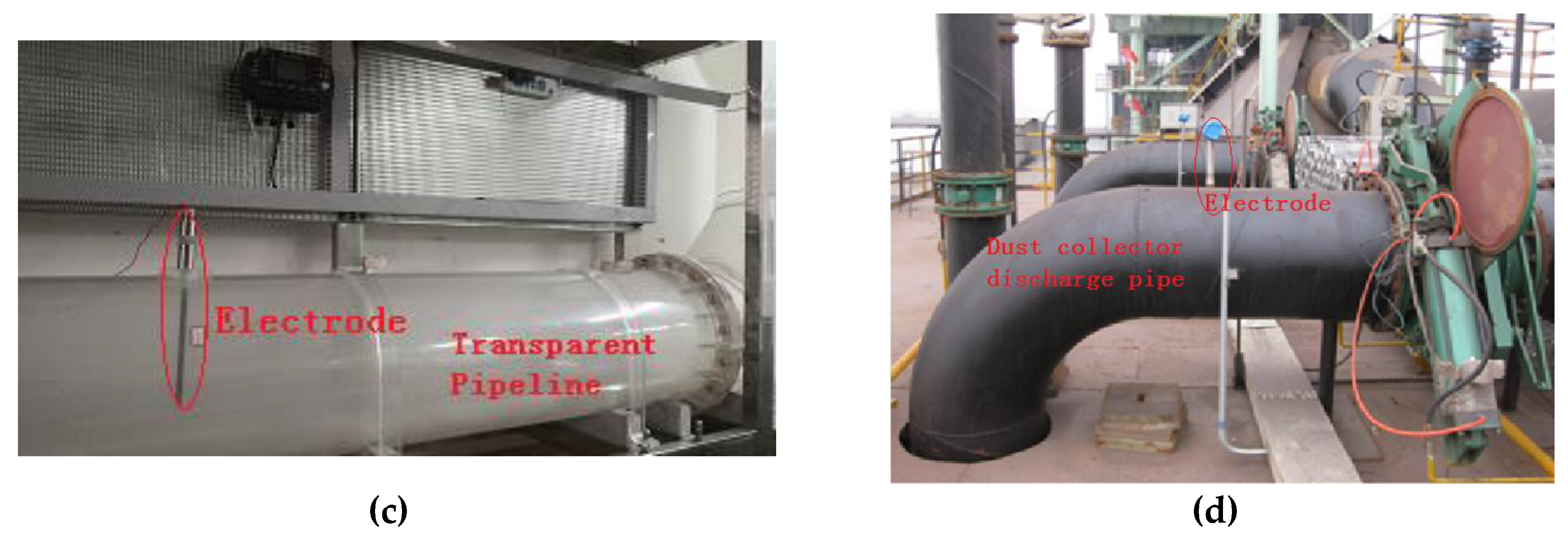

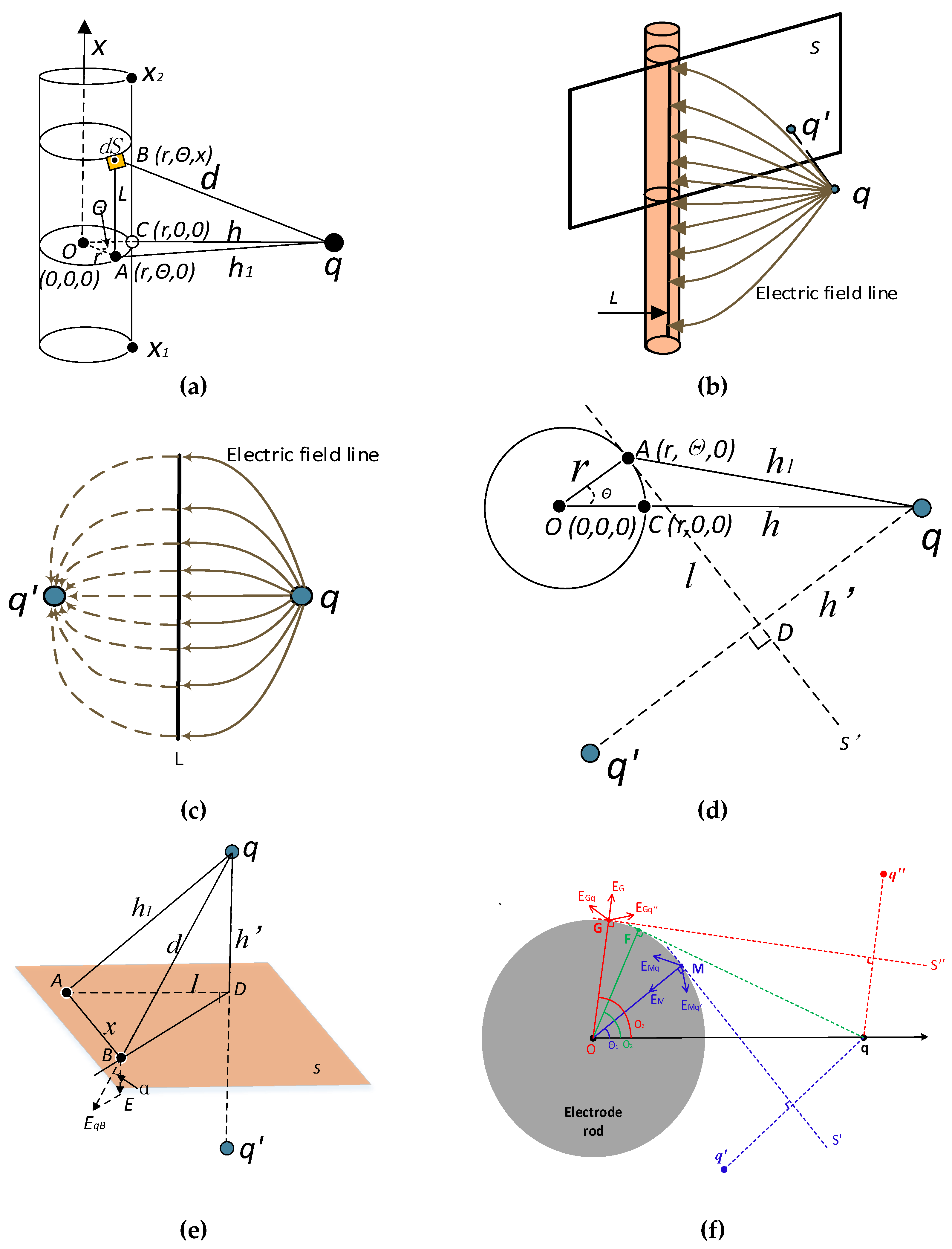

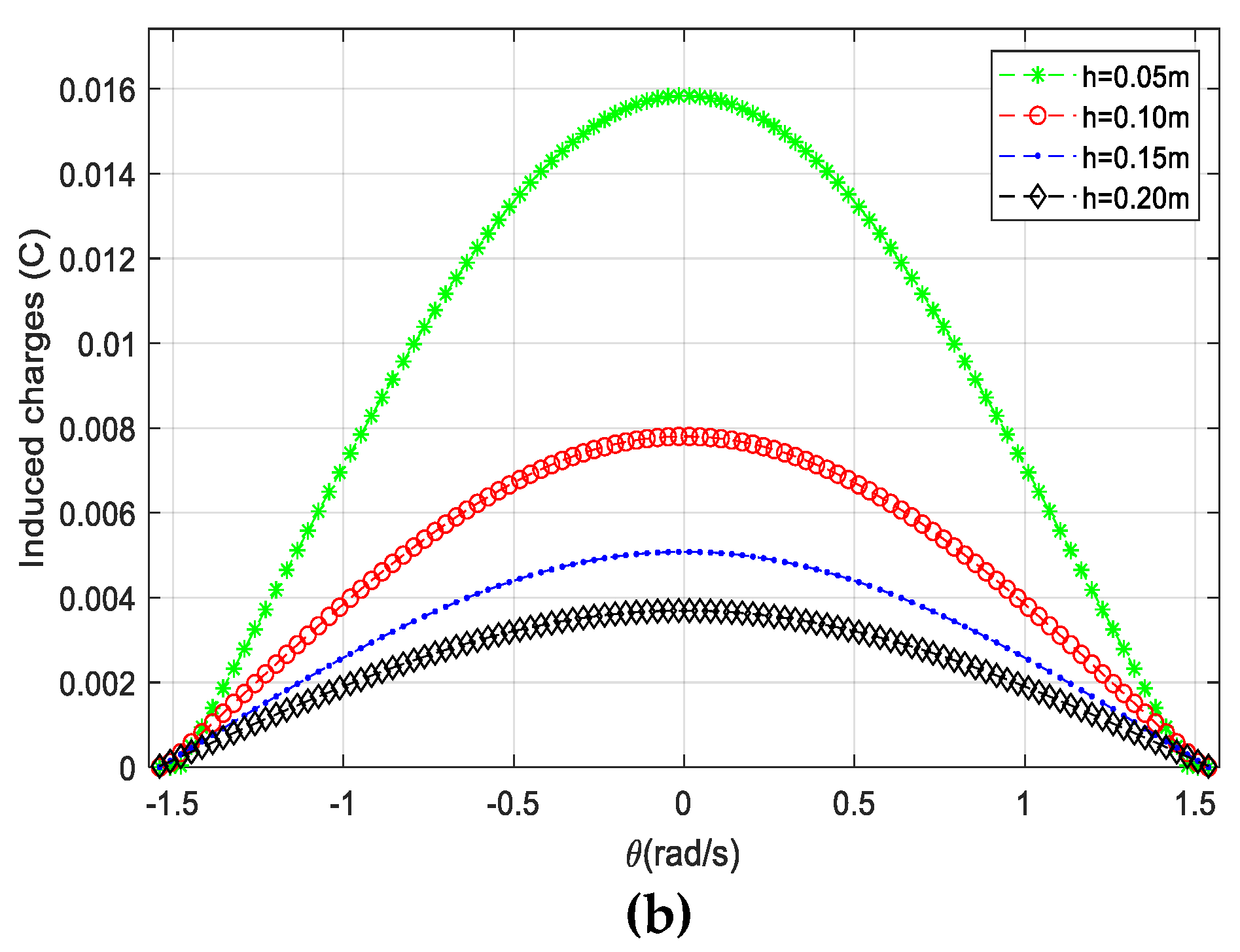

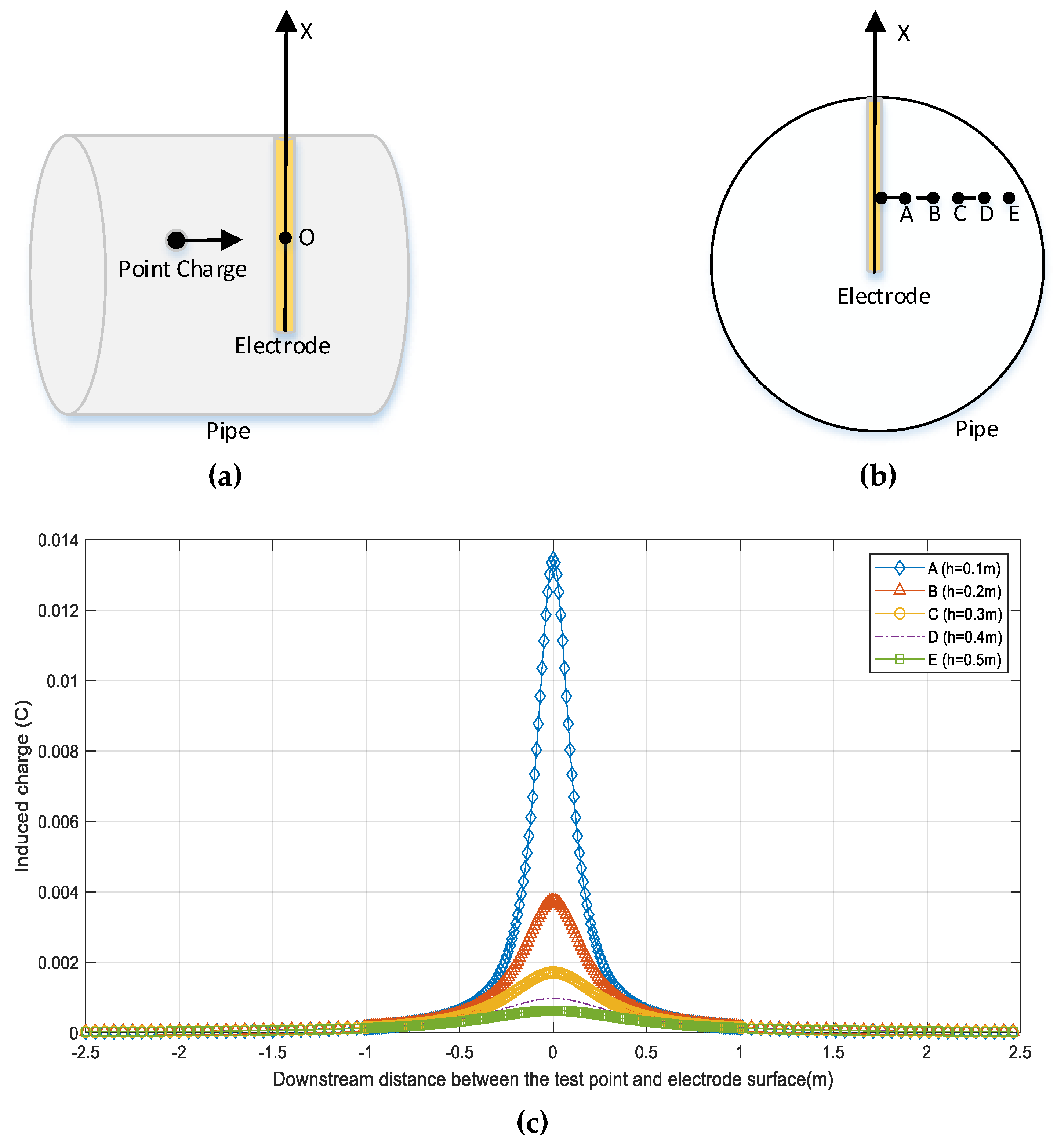

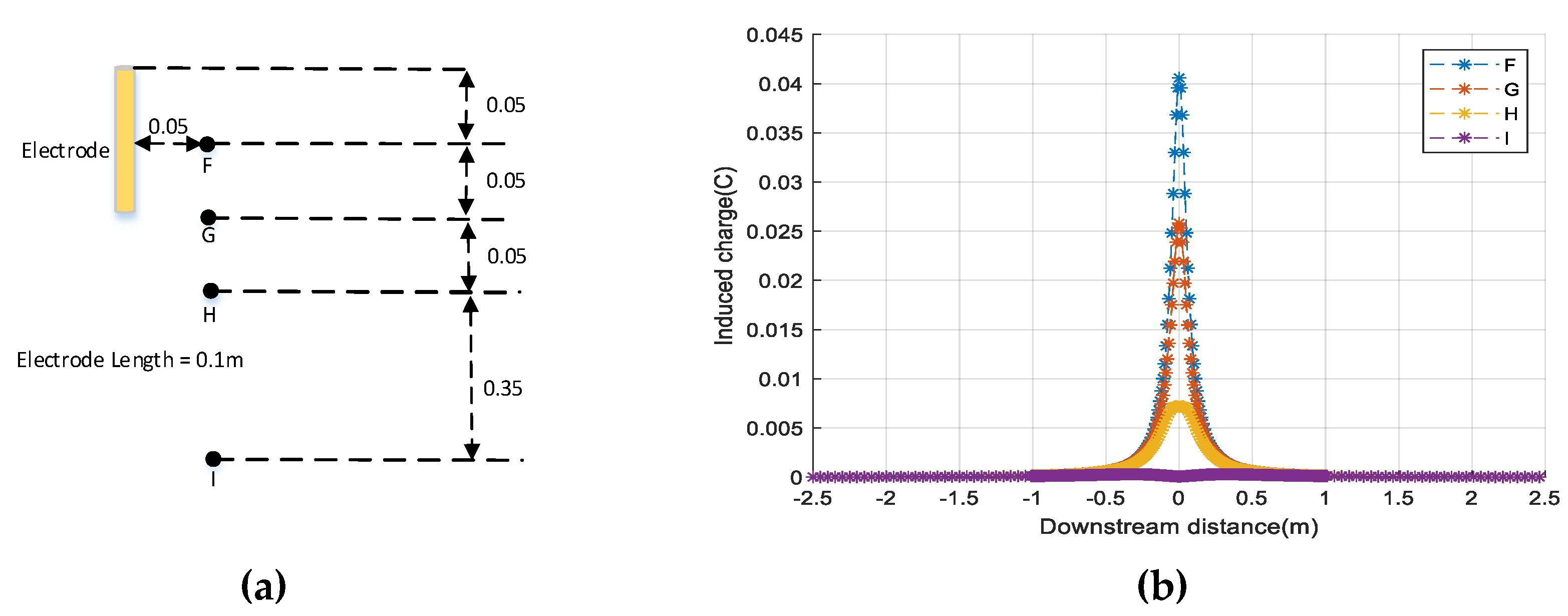



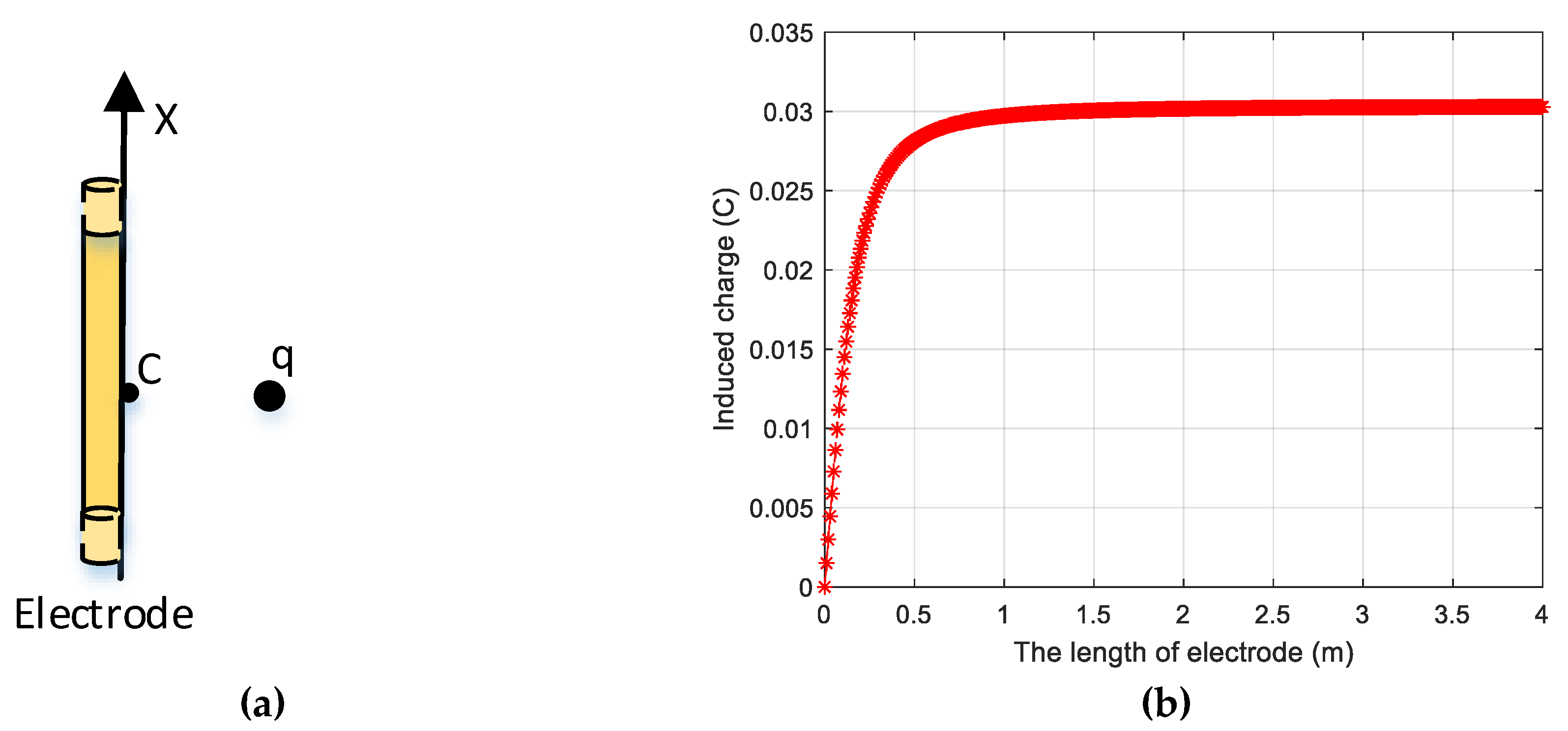
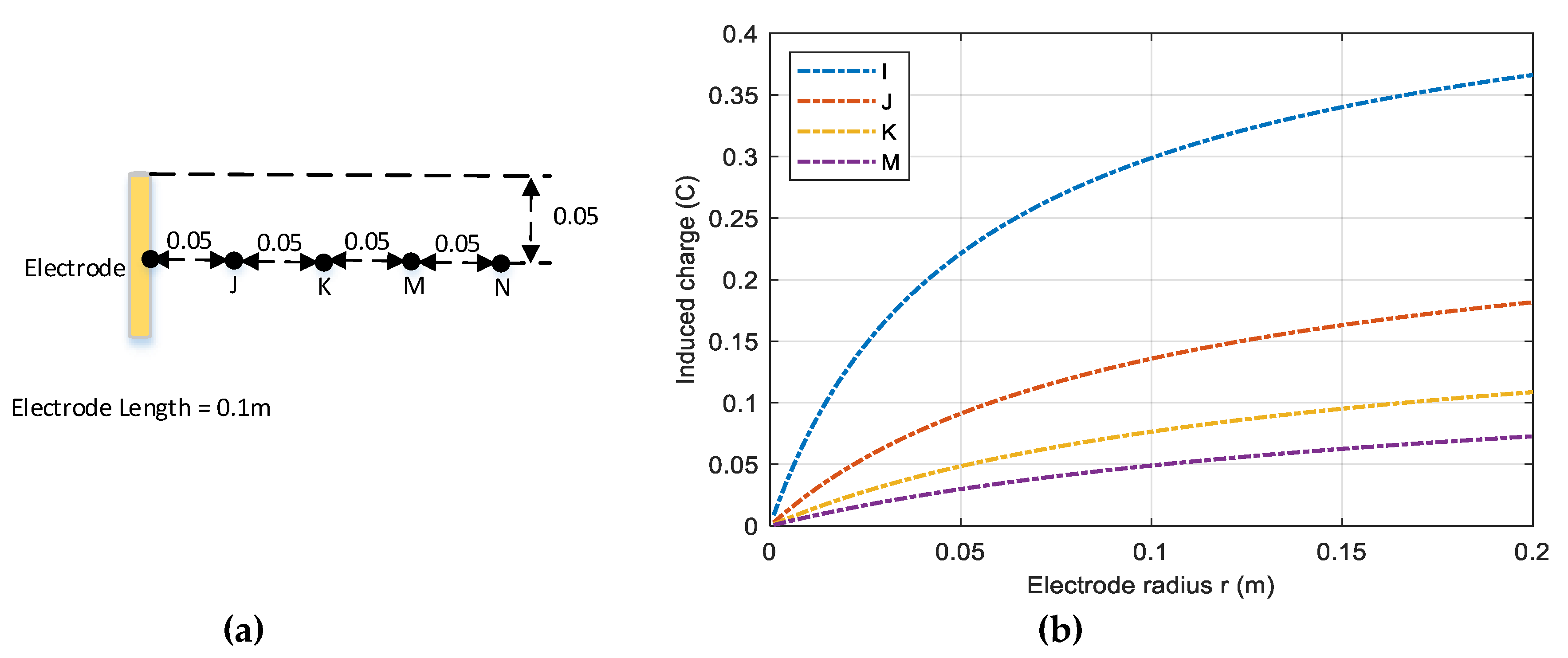


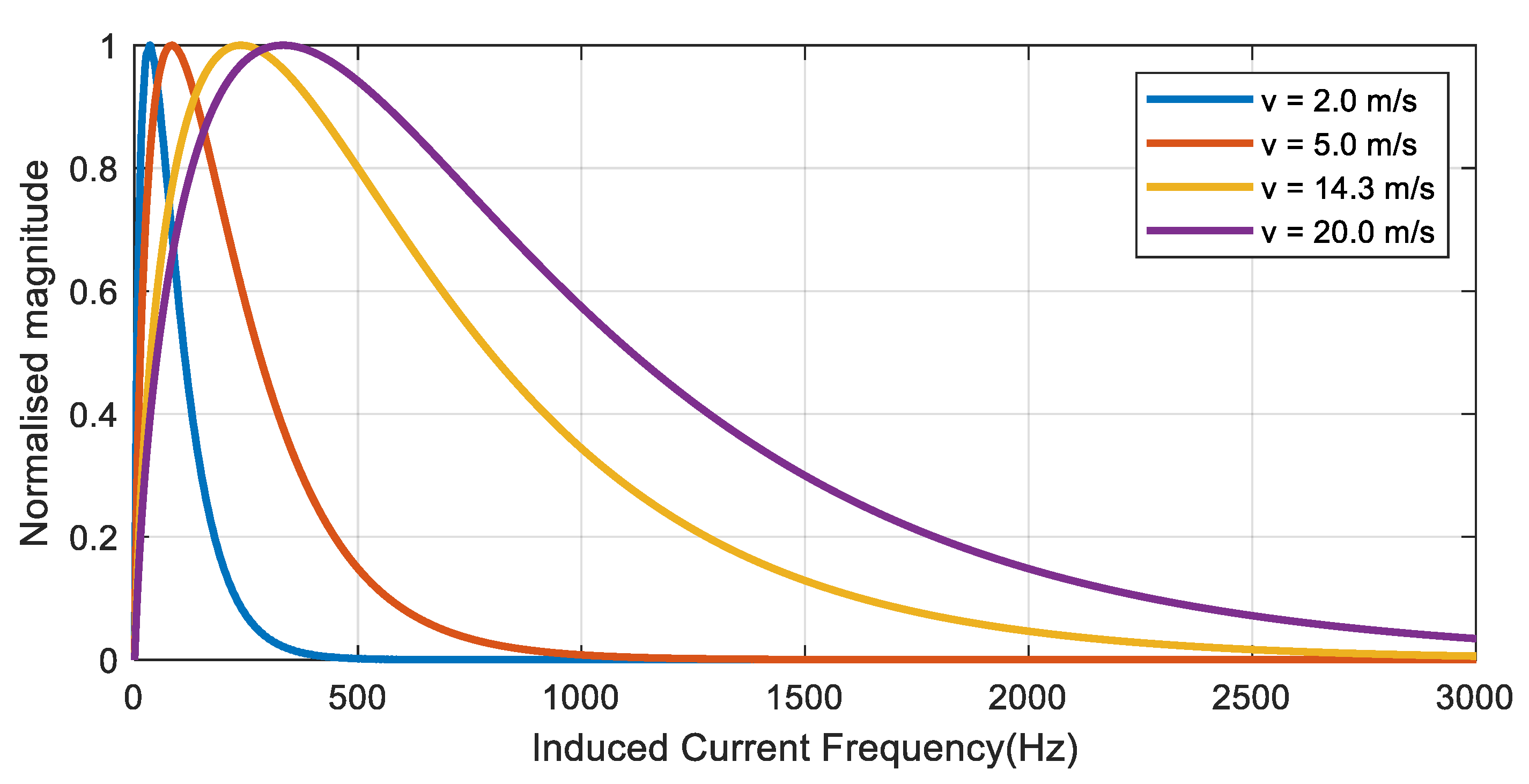
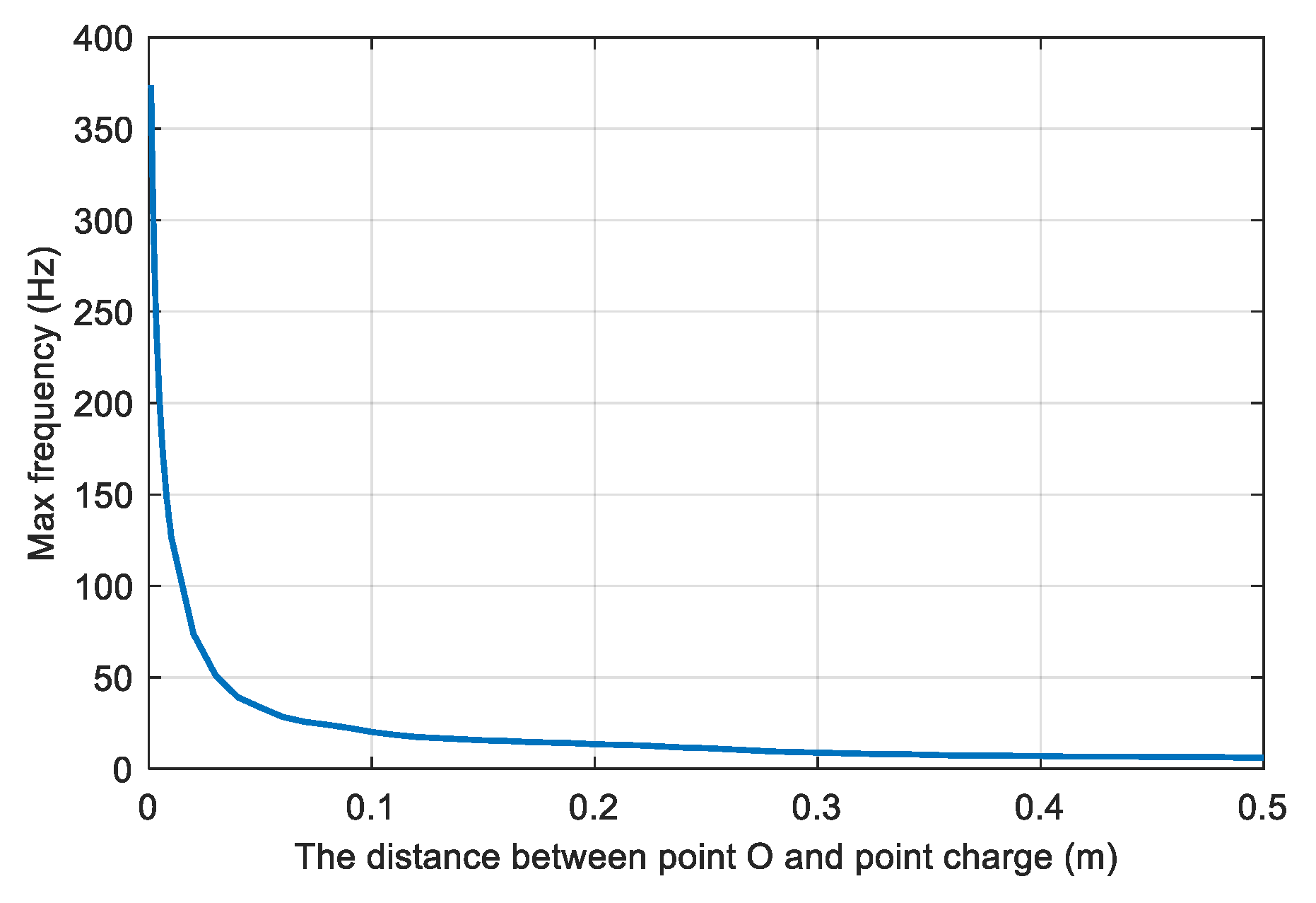


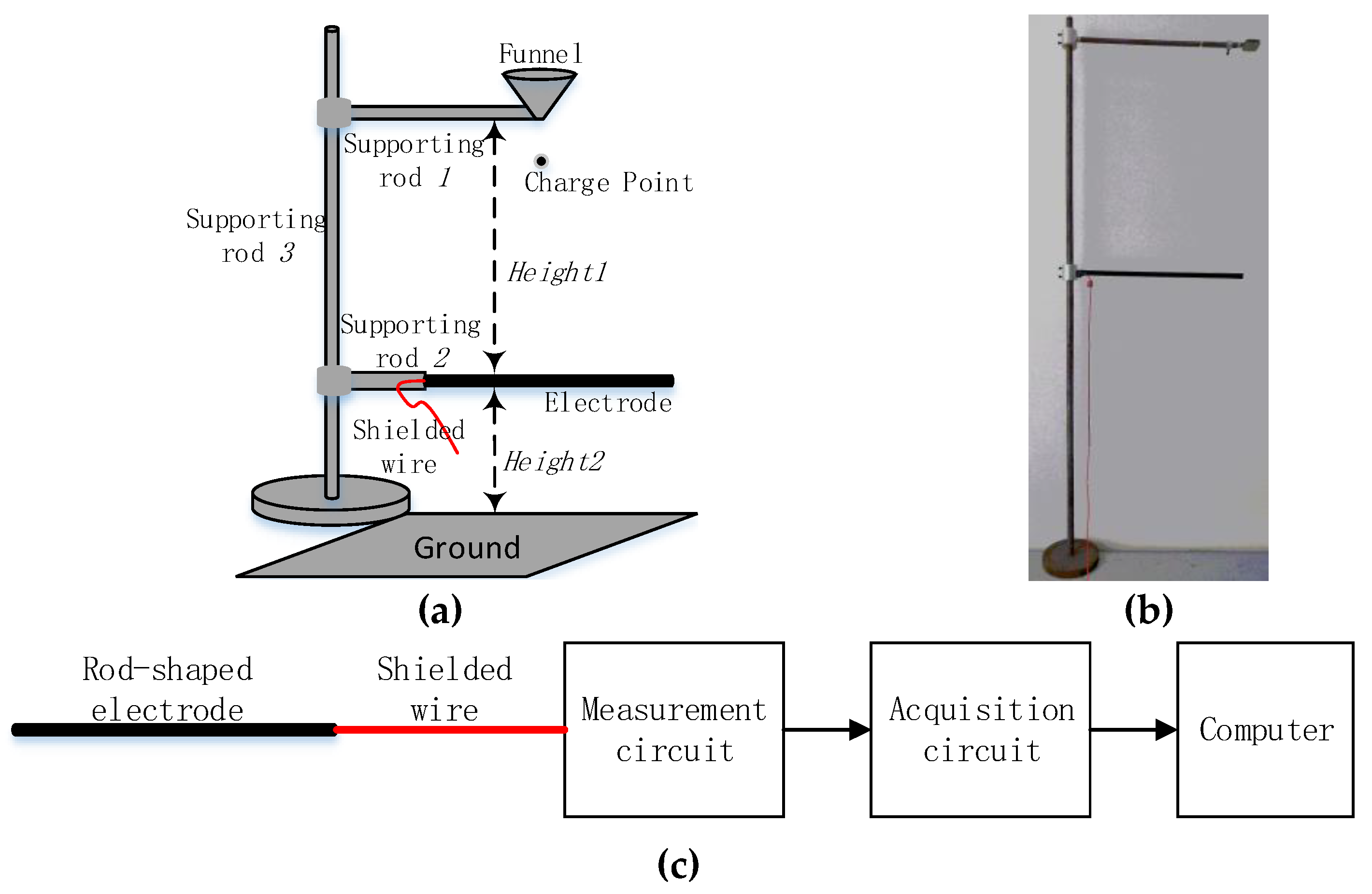
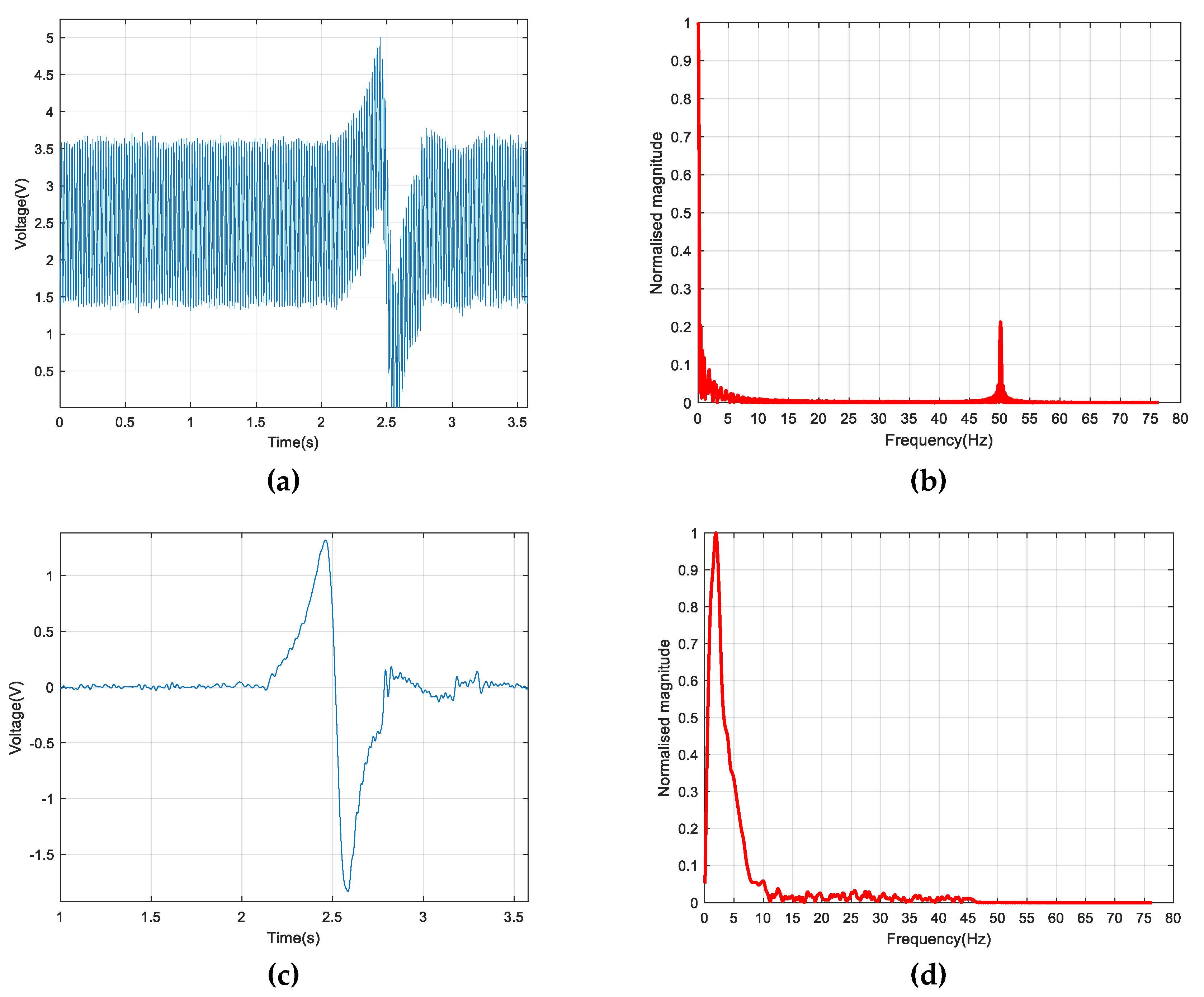

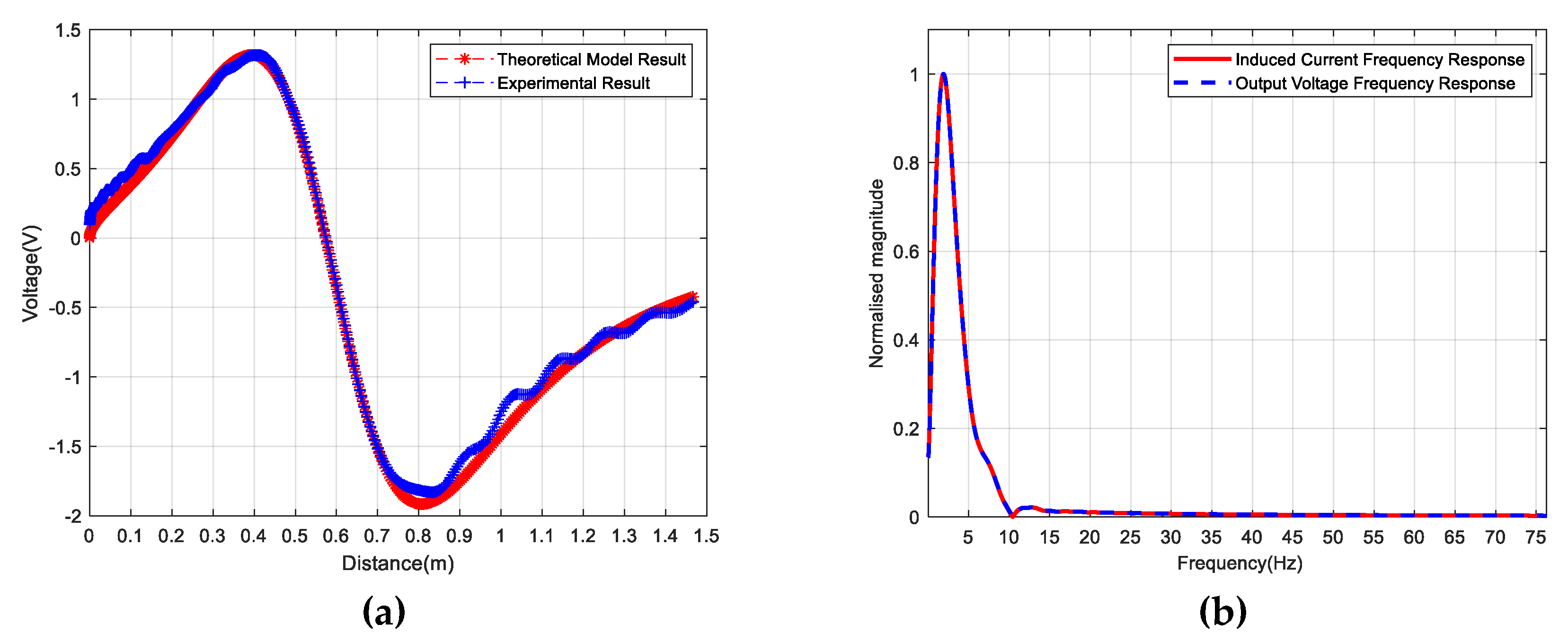
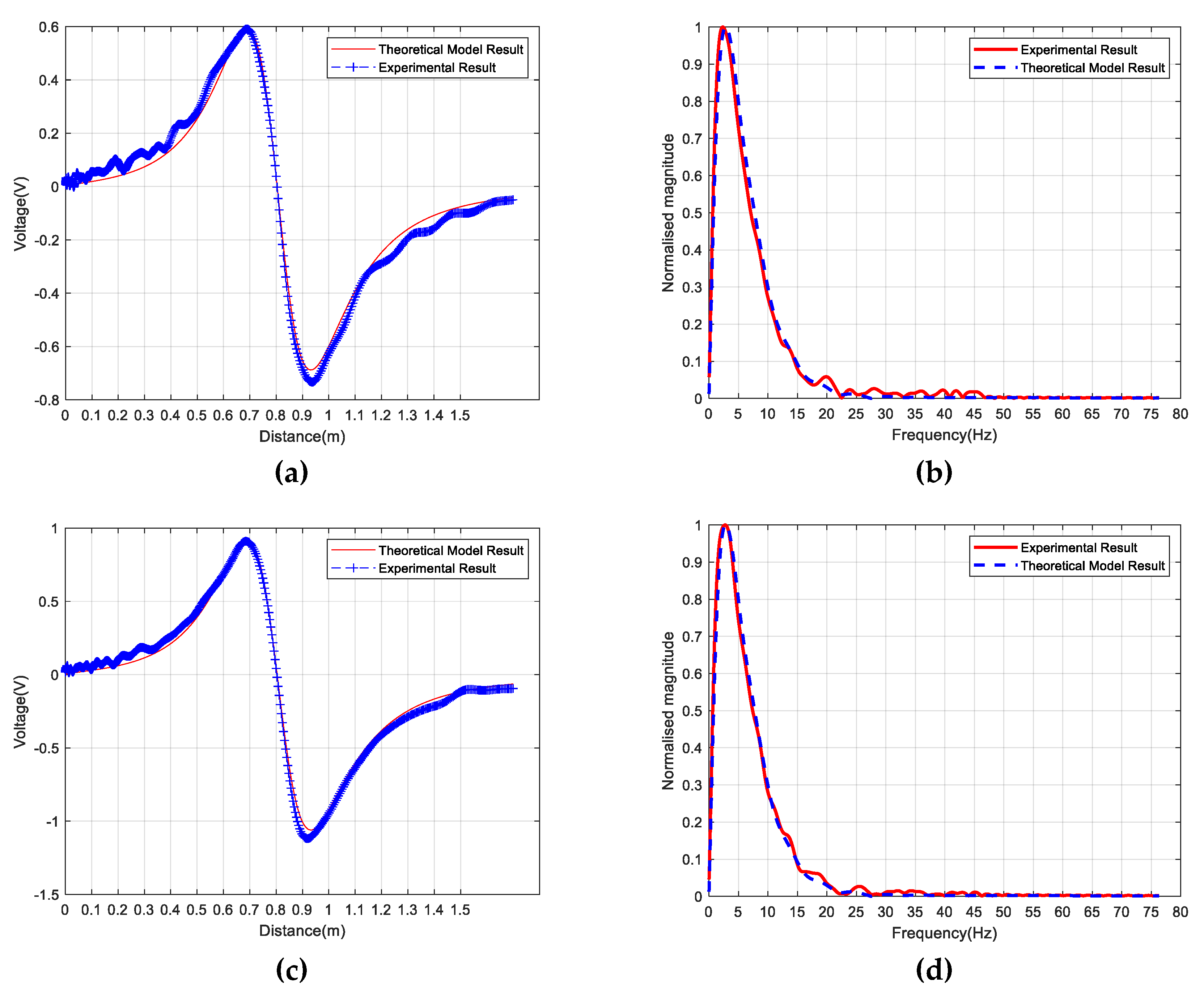

| Charged Ball 1 | Charged Ball 2 | Ratio | |
|---|---|---|---|
| Amount of charge (nC) | 37.13 | 57.22 | 0.6490 |
| Maximum measured value (V) | 0.5909 | 0.9107 | 0.6488 |
| Minimum measured value (V) | −0.7333 | −1.1190 | 0.6553 |
| Measured value at 0.5 m (V) | 0.2788 | 0.4299 | 0.6485 |
| Measured value at 0.6 m (V) | 0.4794 | 0.6864 | 0.6984 |
| Measured value at 1.1 m (V) | −0.4138 | −0.6335 | 0.6531 |
| Measured value at 1.2 m (V) | −0.2881 | −0.4112 | 0.7006 |
© 2019 by the authors. Licensee MDPI, Basel, Switzerland. This article is an open access article distributed under the terms and conditions of the Creative Commons Attribution (CC BY) license (http://creativecommons.org/licenses/by/4.0/).
Share and Cite
Li, J.; Li, J.; Cheng, X.; Feng, G. Investigation of Induced Charge Mechanism on a Rod Electrode. Electronics 2019, 8, 977. https://doi.org/10.3390/electronics8090977
Li J, Li J, Cheng X, Feng G. Investigation of Induced Charge Mechanism on a Rod Electrode. Electronics. 2019; 8(9):977. https://doi.org/10.3390/electronics8090977
Chicago/Turabian StyleLi, Jiming, Jingyu Li, Xuezhen Cheng, and Guojin Feng. 2019. "Investigation of Induced Charge Mechanism on a Rod Electrode" Electronics 8, no. 9: 977. https://doi.org/10.3390/electronics8090977





